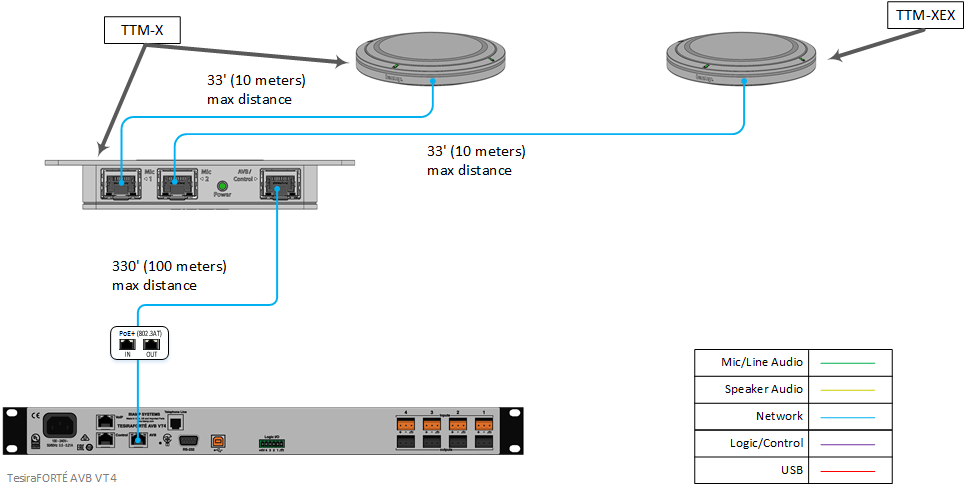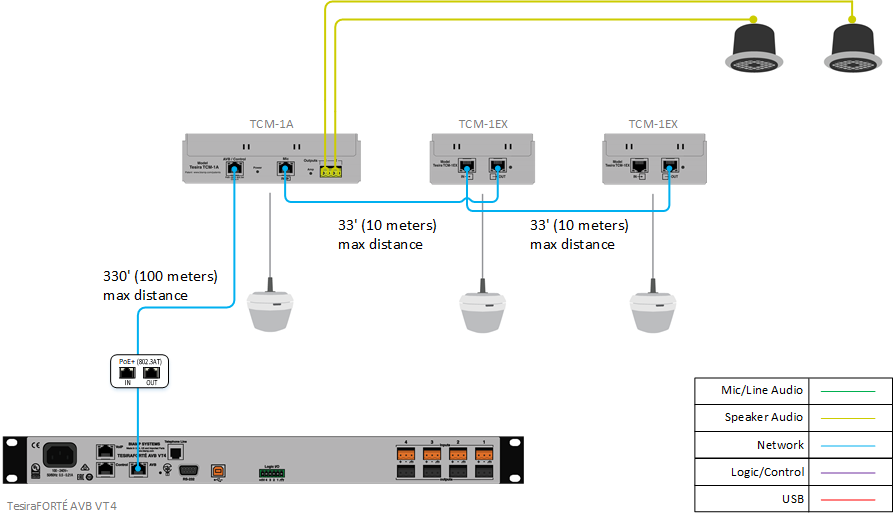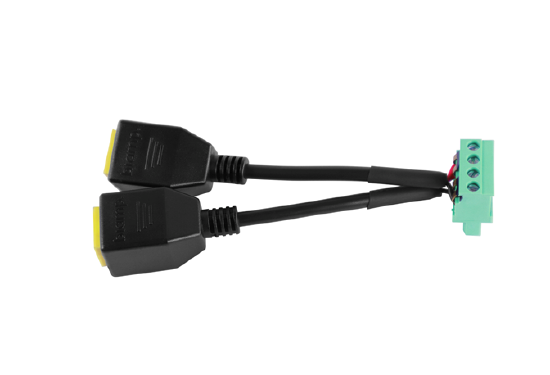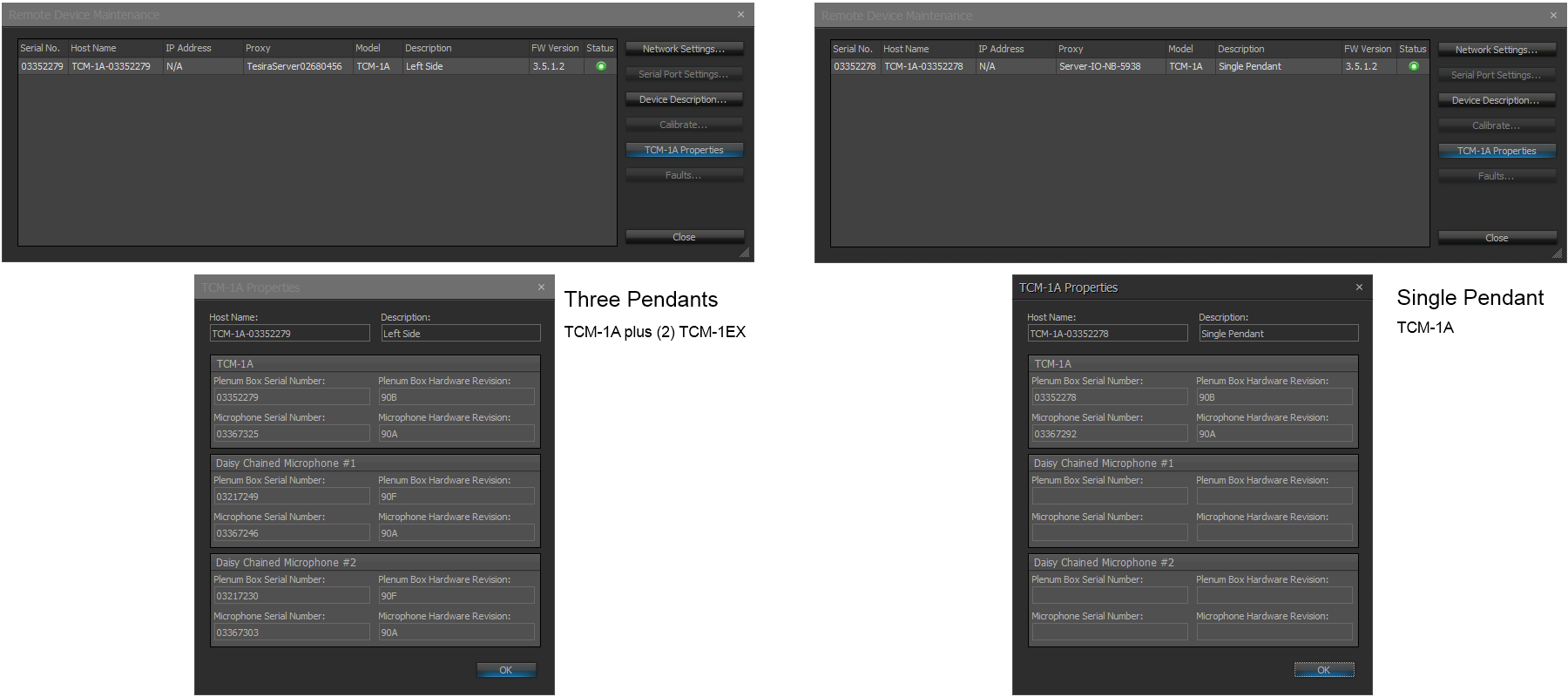Parlé-series Beamtracking Microphones
The following article provides information about Biamp's Parlé-series Beamtracking™ Microphones. It discusses some of the core technologies that make these microphones work, as well as the resources available in software for setup and configuration.
Hardware overview
| TCM-X | Plenum network box + one ceiling-mount microphone array |
| TCM-XA | Plenum network box with built-in amplifier + one ceiling-mount microphone array |
| TCM-XEX | One expansion ceiling-mount microphone array |
| TTM-X | Under-table network box + one tabletop microphone array |
| TTM-XEX | One expansion tabletop microphone array |
| TCM-1 | Plenum network box + one microphone array pendant |
| TCM-1A | Plenum network box with built-in amplifier + one microphone array pendant |
| TCM-1EX | Extension plenum network box + one microphone array pendant |
Topology
TCM-XA/TCM-XEX/TCM-X
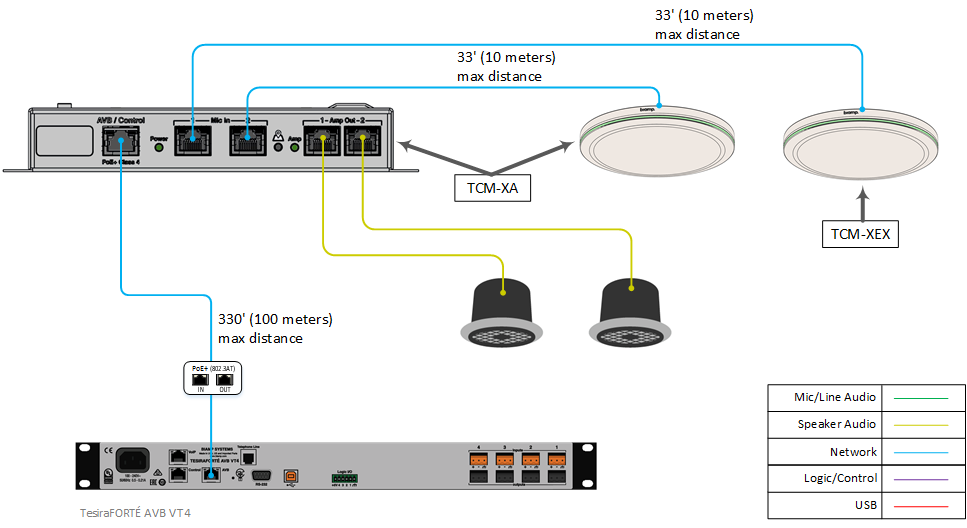
Cabling
Each TCM-1 or TCM-1A can host up to two TCM-1EX extension microphones connected in a daisy chain using standard CAT5 or better cable. This means that, with just a single cable run from the ceiling down to the DSP, you can have coverage from three beamtracking microphone arrays, which should be suitable for most small to mid-sized conference room applications.* The TCM-X and TTM-X have a slightly different topology. Each AVB network box supports up to two microphone arrays. So you can use one TCM-X (or TCM-XA) and add a single TCM-XEX expansion microphone array to the same network box. The same applies to the TTM-X and TTM-XEX.
There is a maximum distance of 330' (100 meters) between any network box and the AVB capable network switch. Point-to-point cabling between the TCM-1 / TCM-1A and the first TCM-1EX has a limitation of 33' (10 meters). Point-to-point cabling between the first and second TCM-1EX units also has a limitation of 33' (10 meters). In all models, the supplied pendant microphone allows a maximum drop of 10 feet (3 meters) including any strain relief within the plenum ceiling box. TCM-1 pendants are available in white or black.
The maximum distance between the network box and microphone array for the TCM-X, TCM-XEX, TTM-X, or TTM-XEX is 33' (10 meters). Note that this total distance includes the 6.5' (2 meter) cable provided with the TTM table top microphone array. The TTM cable can be extended a maximum of 26.5' (8 meters) beyond the included cable. The cable can be extended with an RJ-45 coupler and additional CAT cable.
*When installed at a height of 8’ (2.5 meters), the Parlé Beamtracking Microphone maintains a STIPA A rating over a coverage diameter of 16’ (5 meters). Room conditions at time of measurement: RT60 (@5meters) = 425ms, Noise Floor weighted (at the microphone) = 38dBSPL-A.
Integration of TCM-1A with Desono C-IC6
In addition to integration with amplifiers that utilize Biamp's RJ45 speaker connection, the Biamp Category Cable Adapter can also be used to allow for an additional wiring option when using Desono C-IC6 speakers with the TCM-1A amplifier. The Desono C-IC6 utilizes both RJ45 and Euroblock connections for versatility making connectivity via CAT5 or conventional speaker cable available. Connectivity via CAT5 cabling simplifies field termination and install time. Verify the provided Euroblock connector wiring matches with manufacture pinout for the amplifier. The adapter may also be used with the output connector that is provided with the amplifier as a single or dual connection as shown in the diagram below utilizing a pair of Category Cable Adapters. Adapters are rated for up to 300V load.
Additionally, the Category Cable Adapter can be used to connect the RJ45 ports of a TCM-XA to a generic speaker that does not have RJ45 ports.
Device Power
Each network box receives power over the Ethernet connection. The power requirements of each device are as follows:
| TCM-X | PoE (IEEE 802.3at Class 3, 15.4W) |
| TCM-XA | PoE+ (IEEE 802.3at Class 4, 30W) |
| TCM-XEX | Powered from network box included with TCM-X or TCM-XA |
| TTM-X | PoE (IEEE 802.3at Class 3, 15.4W) |
| TTM-XEX | Powered from network box included with TTM-X |
| TCM-1 | PoE (IEEE 802.3at Class 3, 15.4W) |
| TCM-1A | PoE+ (IEEE 802.3at Class 4, 30W) |
| TCM-1EX | Daisy chained from TCM-1 or TCM-1A, power provided by host TCM-1 or TCM-1A |
Network boxes may be directly connected to the AVB port on a Tesira server class device using a PoE+ injector, or via a PoE+ port on an AVB capable network switch.
Core technologies
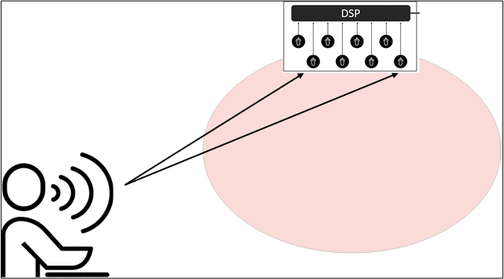 Beamforming is the ability to shape or steer a microphone array's directivity (or polar) pattern. Consider the situation where you have multiple microphones in a room, or in this case, multiple elements in an array. Sound will arrive at each microphone with a different time delay and level decay.
Beamforming is the ability to shape or steer a microphone array's directivity (or polar) pattern. Consider the situation where you have multiple microphones in a room, or in this case, multiple elements in an array. Sound will arrive at each microphone with a different time delay and level decay.
By utilizing DSP, we can shape the pickup pattern by compensating for the delay and level differences between microphones. A single TCM-1 pendant has eight microphone elements working together to create three 120° zones, each with its own steerable beam. This allows for a full 360° of coverage. A single TCM-X or TTM-X microphone array has 16 microphone elements to create four 90° zones with the same steering ability.
This is all well and good, but beamforming is nothing new, and there are plenty of other microphones out there utilizing this technology. What makes the Parlé series unique is that the microphones use beamtracking technology to analyze the signals from each microphone element in order to determine where the talker is, then passes that information on to the beamforming algorithm to tell it where to steer the polar pattern. This is accomplished, in part, by a process called Voice Activity Tracking.
Voice Activity Tracking
When a signal enters the Parlé microphone array, it diverges into two paths: the audio signal that is sent over AVB to the Tesira server-class device, and a signal used for tracking. The tracking algorithm makes use of aggressive noise cancelation to ensure that noise sources in a room, such as ceiling mounted projectors and HVAC systems, do not cause the tracker to falsely trigger. 
Parlé microphone arrays are optimized to only track signals within the frequency domain of human speech,empowering the tracking algorithm to give greater focus to talkers in the room. It then passes this information on to the beamformer, which directs its polar pattern to the located talker.
The tracker will follow in both azimuth (left-right) and elevation (up-down) angles and will work independently in each of the available zones.
Beam Weighting
Adding tracking capabilities to the beamforming microphone array creates a problem for us to solve. If two beams in a single pendant track to the same talker, such as may occur if that person is positioned between two coverage zones, it could introduce comb filtering or other phasing issues. To combat this, we implemented the concept of beam weighting. When two beams are directed toward the same talker, each signal is analyzed and only the stronger signal will be selected to pass through to the remainder of the signal chain.
Beam weighting prevents phasing issues that could occur from two beams tracking to the same signal. However, when the signals are different, such as when two people are talking, it does not stop multiple beams from being used to properly pick up talkers across multiple coverage zones. This processing takes place within the network box.
Intelligent Mixing
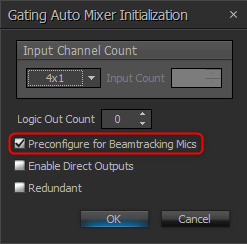 Beam weighting addresses the issue of a single talker being covered by multiple beams in a single microphone array, but what about a single talker being covered by beams from multiple microphone arrays? For this, we introduced the concept of Intelligent Mixing.
Beam weighting addresses the issue of a single talker being covered by multiple beams in a single microphone array, but what about a single talker being covered by beams from multiple microphone arrays? For this, we introduced the concept of Intelligent Mixing.
If there are two microphone arrays in a room, they will both track to a human voice source. Intelligent mixing, which occurs post-tracking algorithm, allows the system to identify which pendant has the better signal and deliver that to the final mix. This only applies to a common source. With separate signals in a room, multiple microphone arrays can still be active.
Intelligent Mixing for beamtracking microphones is enabled within the Gating Auto Mixer block when adding it to the Tesira layout file. In the Gating Auto  Mixer initialization dialog, select "Preconfigure for Beamtracking Mics." This will optimize the auto mixer settings for use with the Parlé-series microphones. The lower-righthand corner of the Gating Auto Mixer will show "BT" as a visual indication that this option has been chosen.
Mixer initialization dialog, select "Preconfigure for Beamtracking Mics." This will optimize the auto mixer settings for use with the Parlé-series microphones. The lower-righthand corner of the Gating Auto Mixer will show "BT" as a visual indication that this option has been chosen.
AEC Interaction
Biamp's Beamtracking Microphones are ultimately designed with conferencing and collaboration in mind, and you cannot talk about conferencing without mentioning Acoustic Echo Cancellation (AEC). AEC performance is one of the most -- if not the most -- critical processing components in an audio conferencing system. Because Biamp has created both the beamtracking and AEC algorithms within Tesira, both are aware of and communicate with each other to help ensure a quality meeting experience.
One channel of AEC processing is required for each Parle microphone input. A TCM-X and a TCM-EX would require 2 channels of AEC (1 per microphone). A TCM-1 with 2x TCM-1EX would require 3 channels of AEC (1 per pendant).
When the far end talks, a beamtracking microphone will analyze this signal, identify it as human speech, and want to track to it. However, our AEC algorithm is capable of telling the beamtracker that it is the far end who is talking. This will temporarily lock the beams in place, preventing them from tracking to the far end voice coming out of the room's loudspeakers.
This interaction between our AEC and beamtracking algorithms is patented technology that allows for the requirement of only a single channel of AEC per microphone array. This scenario would typically require three channels of AEC (one for each beam or coverage zone).
Software and programming
Adding Biamp Beamtracking Microphones to a layout is a simple process and resources have been provided to aid in the configuration. Below, we will highlight the blocks that should be included when programming the layout, as well as the options available to optimize settings for use with Parlé microphones.
Parlé microphones require an AVB-capable Tesira DSP. They cannot be connected to a TesiraFORTÉ DAN via TC-5D. If Dante IO is required they can be used with a TesiraFORTÉ X or Tesira Server-IO, both of which support both AVB and Dante connections. 1 channel of AEC input processing is required per Parlé mic capsule when used for conferencing.
Parlé I/O Blocks
Parlé microphones are added to the configuration from the I/O Blocks list found under the Audio Object Bar.
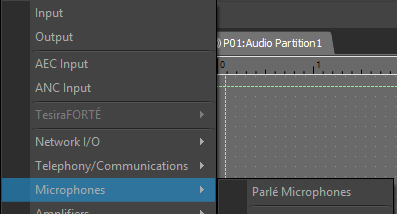
Once the appropriate model is selected and added to your layout, an initialization dialog will be shown.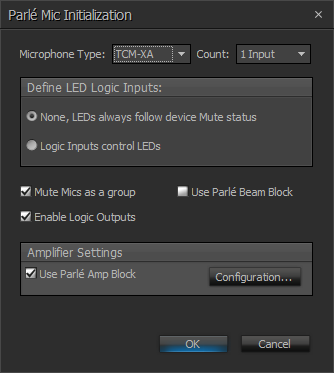 This allows you to configure the following:
This allows you to configure the following:
- Microphone Type (TCM-1, TCM-1A, TCM-X, TCM-XA, or TTM-X)
- Microphone Count (depending on the number of total microphone arrays connected to the network box)**
- Logic Inputs for LED control and muting
- Mute options for multiple microphones as a group, or individually
- Enable logic outputs that could be used to drive logic functions within Tesira based on mic mute state
- Enable individual beam outputs (TCM-X, TCM-XA, TTM-X only)
- Add or remove the amp block when utilizing the TCM-1A or TCM-XA built in amplifier
** TCM-1 and TCM-1A allow a maximum microphone count of 3. TCM-X, TCM-XA, TTM-X allow a maximum microphone count of 2.
After confirming the configuration and selecting OK, the blocks will be added to the layout. For example, choosing a TCM-XA with a microphone count of 2, a TCM-1A with a microphone count of 3, each with an amplifier included, will add the following blocks to the layout:
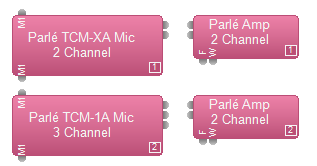
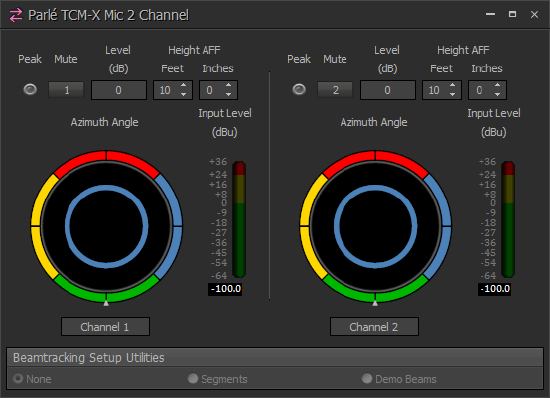 The Control Dialog for the Parlé Input block will display based on the number of microphones chosen. A software representation of the azimuth tracker will be included for each microphone, as well as mute, level, height settings, and an RMS meter.
The Control Dialog for the Parlé Input block will display based on the number of microphones chosen. A software representation of the azimuth tracker will be included for each microphone, as well as mute, level, height settings, and an RMS meter.
When connected live to the system, the azimuth tracker will display an indicator for each beam or coverage zone, and will provide feedback for activity and tracking within that zone. The TCM-X and TTM-X microphone arrays will show a red, green, blue, and yellow indicator to represent the four available beams. The TCM-1 microphone array will show a red, green, and blue indicator to represent the three available beams.
The height should be set at the measured distance from floor to microphone array. This will affect the maximum upward angle at which the microphone will track. A higher setting will limit the angle, keeping the beam from tracking too close to sources coming from the ceiling. A lower setting will increase the coverage angle to accommodate talkers being nearer to the mic's 0° elevation angle.
Height Above Floor (AFF) vs. Tracking Angles
| TCM-X | ||
|---|---|---|
| Height AFF | Min Elevation Tracking Angle | Max Elevation Tracking Angle |
| < 3.65 m (12 ft) | 15° | 75° |
| 3.65 m (12 ft) | 22.5° | 75° |
| 4.15 m (13.6 ft) | 30° | 75° |
| 4.65 m (15.3 ft) | 37.5° | 75° |
| 5.05 m (16.6 ft) | 45° | 75° |
| 5.45 m (17.9 ft) | 52.5° | 75° |
| TCM-1 | ||
|---|---|---|
| Height AFF | Min Elevation Tracking Angle | Max Elevation Tracking Angle |
| < 1.5 m (5 ft) | 0° | 15° |
| 1.5 m (5 ft) | 0° | 30° |
| 1.7 m (5.6 ft) | 0° | 45° |
| 2 m (6.6 ft) | 0° | 60° |
| 2.1 m (6.9 ft) | 0° | 75° |
| 3.2 m (10.5 ft) | 15° | 75° |
| 4.2 m (13.8 ft) | 30° | 75° |
| 5.1 m (16.7 ft) | 45° | 75° |
AEC Processing Block
In most cases, a Parlé microphone input will first be connected to an AEC processing block. 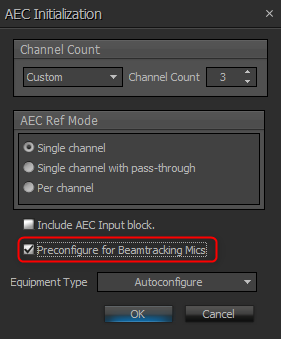 The recommended configuration for the AEC processing block when used in conjunction with a Biamp Beamtracking Microphone is as follows:
The recommended configuration for the AEC processing block when used in conjunction with a Biamp Beamtracking Microphone is as follows:
NLP = Medium
Noise Reduction = Low
AGC = Bypassed
To quickly deploy these settings, a "Preconfigure for Beamtracking Mics" option has been added to the AEC initialization dialog. The most critical of these settings is to ensure that AGC is bypassed. When utilizing beamtracking microphones, we want AGC to occur post-automixer. This AGC processing will be included automatically when adding the Parlé custom processing block (green or purple) to the layout. If utlizing Parle microphones with AI-NRD blocks, please use the appropriate block from the Processing Library.
One channel of AEC is required per Parlé microphone.
The Parlé microphone has an inherent roll off at 160 Hz resembling a Butterworth High Pass 48dB/octave:

This means that the HPF in the AEC block can optionally be set to 160 Hz to match the inherent curve. Increasing this HPF to 180 and 200 Hz may help minimize pick up of low frequency HVAC noise that commonly occupies the 185 Hz space. Caution is advised at and above 200 Hz as this will have impact on the pick up of lower male voices.
Parlé Processing Block
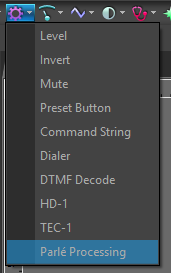 In an effort to simplify setup and deployment, Tesira software (3.14 and later) includes the Parlé Processing Block that is pre-configured with the optimized DSP processing chain for the Parlé series microphones. This will reduce programming time and ensure that recommended steps and settings are followed when including Parlé microphones in your layout. Each Parlé Block will vary by the number of channels, but contain the same processing blocks and a single mixed output.
In an effort to simplify setup and deployment, Tesira software (3.14 and later) includes the Parlé Processing Block that is pre-configured with the optimized DSP processing chain for the Parlé series microphones. This will reduce programming time and ensure that recommended steps and settings are followed when including Parlé microphones in your layout. Each Parlé Block will vary by the number of channels, but contain the same processing blocks and a single mixed output.

The block includes presets optimized for various room acoustic conditions. Refer to the Parlé Processing Block article for additional details.
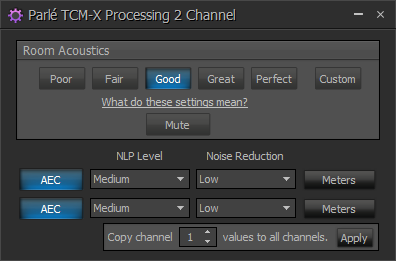
The Room Acoustics presets have been tailored to meet the requirements of several different popular UC platforms. Selecting the correct platform is critical to ensure that the system performs as expected based on extensive testing with each platform. If the system is being used with a UC platform other than those listed, select Generic UC.
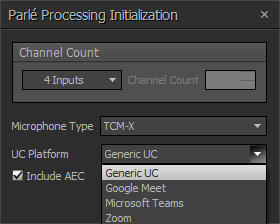
Parlé Amplifier Block
When utilizing the built-in, two-channel amplifier of the TCM-1A or TCM-XA, a two-channel amplifier output block will be added to the layout. This provides controls to set load impedance, level, and mute, as well as monitor the amplifier's current state.
Of particular interest is the Burst indicator. This is a visual indication that Burst power reserves are being utilized to handle peaks in the audio signal.
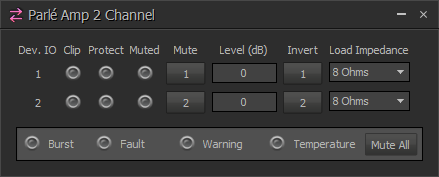
Tracking Limits
NOTE: This feature is not available for the TCM-1, TCM-1A, or TCM-1EX.
The azimuth tracker provides the ability to restrict beam tracking within zones of the microphone's coverage area. The outer edge of the azimuth tracker is divided into multiple segments with a different color for each beam. Each segment is divided into an arc of 45-degrees that can be enabled or disabled to restrict beam tracking in this area. The azimuth tracker is oriented as if you are looking at the microphone from the top down and the small arrow at the bottom represents the location of the Biamp Logo on the microphone. The color-coded arcs are switches and can be turned off to prevent the beam from tracking to noises in that area. Beam segments are turned on or off by clicking on the arc segment and are black when turned off.
The images below illustrate a use case where a beam segment might be disabled to prevent tracking to noises entering a room through a door opening.
![]()
![]()
The next example illustrates a use case where the TTM-X microphone is placed at the end of a small conference table. In this case, you do not want beams active in the areas pointing to the wall display.
![]()
![]()
Beamtracking Setup Utilities
NOTE: These features are not available for the TCM-1, TCM-1A, or TCM-1EX.
The azimuth tracker provides access to two useful setup utilities incorporated in the Parlé microphones. These utilities modify the behavior of the microphone's LED ring.
None
When selected, the LED ring will behave in accordance with the setting in the initialization dialog. It will either follow the behavior of the microphone mute within the block or it is dictated by the state of the logic input nodes for LED control. The Segments and Demo Beams modes operate on a timer and the setting will resort to None after a period of one hour.
Segments
This mode will turn off the segments of the LED ring that have been turned off in the azimuth tracker. This feature is beneficial during installation to identify the physical areas that are currently disabled in the microphone.
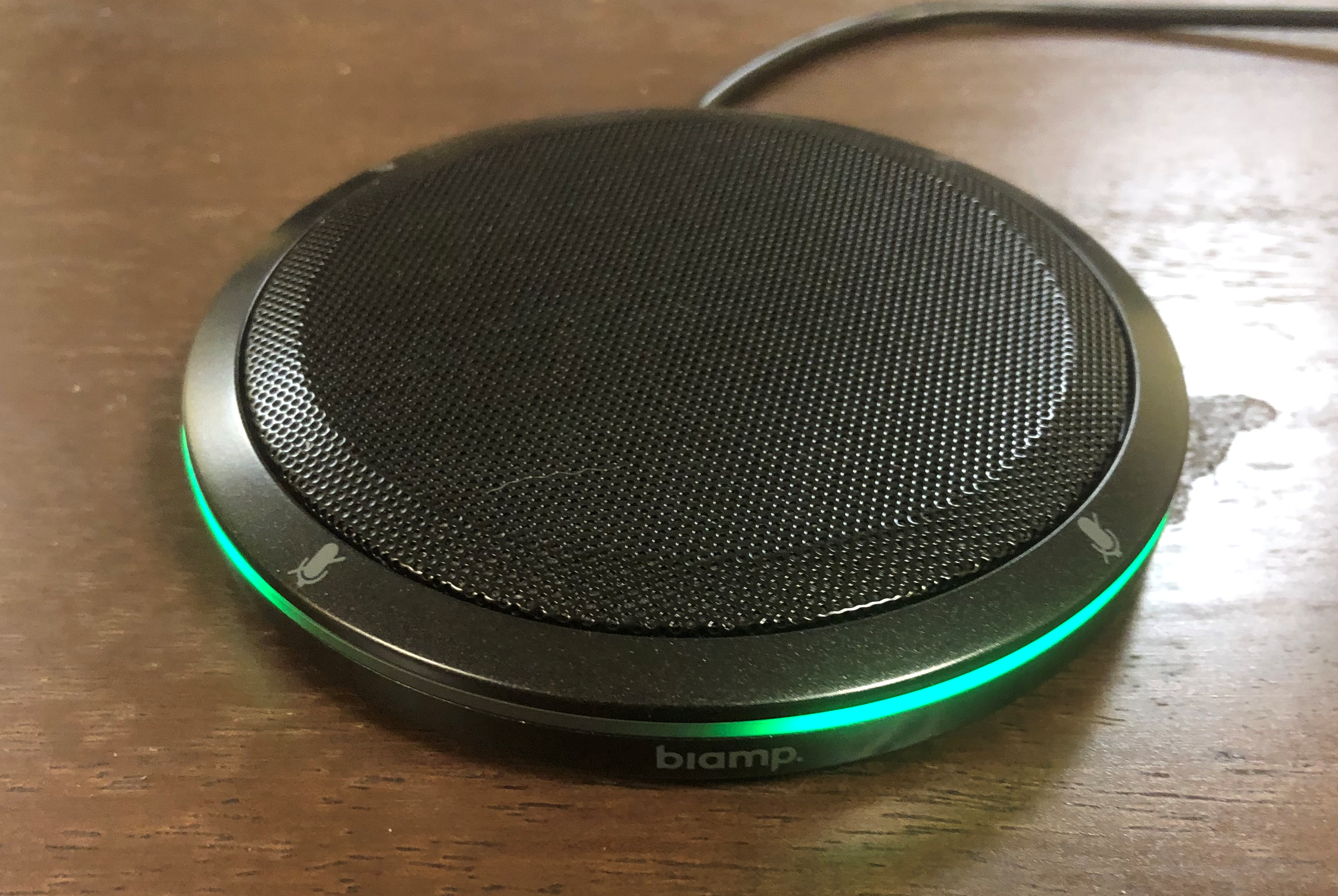
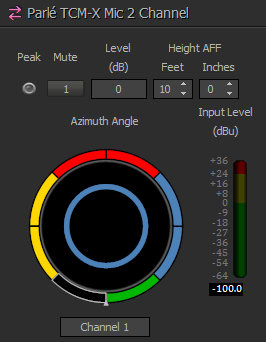
Demo Beams
This mode will cause the individual LEDs in the ring to illuminate around the ring to indicate the position of the actual beam. This allows you to watch which beams are on and where they are pointed during system commissioning. Note that there is a gain sharing automixer built in the microphone to mix the audio signals from the four individual beams into a single audio channel. If no beams are gated on, the ring will go dark.
Parlé Amplifier Connections
Parlé amplifiers uses standard category cables (CAT5/6) to simplify integration with Biamp C-IC6 loudspeakers. Both the amplifier and loudspeaker have RJ-45 jacks for quick connection.
Other loudspeakers can be used with Parlé amps by using the Biamp category cable adapter (CCA) or creating an adaptor using standard CAT cable. The connector utilizes pins 1,2,3, and 6 for speaker (+) and pins 4,5,7, and 8 for speaker (-).
Pairs 1 and 4 (Blue/Brown) are speaker (-) and pairs 2 and 3 (Orange/Green) are speaker (+). Due to this assignment, the resultant connection will be correct regardless of whether T568-A or T-568-B is used. Even a crossover cable will end up with the same pairs utilized for speaker (+) and speaker (-).
.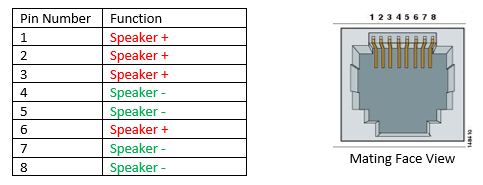

The maximum recommended distance from the Parlé amp to the loudspeaker is 40 meters, or about 130 feet. At this distance there will be almost 3dB loss at the speaker. However, this is specified with the worst case scenario of using 26AWG CAT cable.
The below table shows the distance at which there would be just 1dB of loss to the speaker. With 26 AWG CAT cable the distance before 1dB of loss is almost 15 meters (50 feet). With the Parlé amp mounted near the speaker location, cable lengths are usually shorter than when run back to a rack mounted amplifier in a remote location. Standard CAT-5e cable generally uses 24 AWG conductors, which will allow for runs up to 23 meters (75 feet) before a loss of 1dB is incurred.
| CAT Wire Gauge | 4x Equivalent Gauge | Length (1dB loss to 8Ω speaker) |
| 26 AWG | 20 AWG | 46.25 ft. |
| 24 AWG | 18 AWG | 75.09 ft. |
| 23 AWG | 17 AWG | 92.90 ft. |
| 22 AWG | 16 AWG | 119.3 ft. |
Please note that there is no designation or recommendation made regarding the type of CAT cable to use outside of wire gauge. Shielded cable is NOT required. CAT5e or CAT6a will work just fine, but so will any other standards-based category cable terminated with RJ-45 connectors.
On the Biamp loudspeaker, the RJ-45 and Euroblock / Phoenix connectors are all wired in parallel. Either one or a mix of each could be used depending on the requirements of the installation. The Biamp category cable adapter (CCA) is available to convert inline from RJ-45 to Euroblock / Phoenix (female).
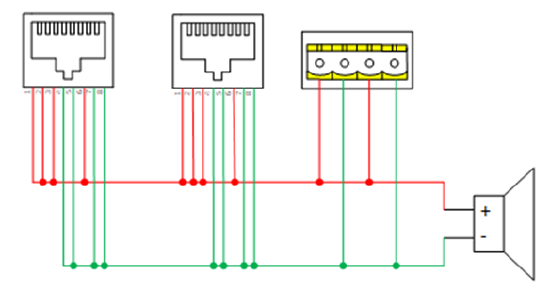
Discovery and communications
The Parlé series microphones are Audio Expander-class devices. This means that they require a Server-class device (TesiraSERVER, TesiraSERVER-IO, or TesiraFORTÉ) to be present in order for them to be discoverable and manageable in Tesira software. Unlike other audio expander devices, Parlé microphones are not assigned an IP address for control communications. AVB's AVDECC (Audio Video Discovery, Enumeration, Connection management, and Control) protocol is utilized for this.
Parlé microphones still adhere to Tesira's discovery and communications rules that other audio expander devices require. This means that AVB devices must still be correctly configured to operate in either converged or separated mode.
A common system design utilizing a Parlé microphone includes a single Server-class device, such as the TesiraFORTÉ VT4, with the microphone directly connected to the TesiraFORTÉ VT4's AVB port through a PoE+ injector. Since the AVB and Control networks are physically separated, this setup will require separated networks to be enabled on the Server-class device in order for it to discover and communicate with the microphone.
Please reference the essential rules for implementing separated networks to ensure success in configuring device discovery and communications. In separated network mode, the AVB and Control IP addresses must be in different subnets. If the microphone does not appear in Remote Devices, double-check to verify that the port IP addresses are not in conflict with these rules.
Device Count
The following device count limits apply to all Tesira systems running firmware version 3.5 or newer:
- Each SERVER or SERVER-I/O can act as the proxy for up to 24 expander devices in systems that include the TCM-X, TCM-XA, TTM-X, TCM-1, TCM-1A, AMP-450P or EX-UBT.
- Each TesiraFORTÉ can act as the proxy for up to 12 expander devices in systems that include the TCM-X, TCM-XA, TTM-X, TCM-1, TCM-1A, AMP-450P or EX-UBT.
- Additional details on system device limits can be found in the System Limits section of Tesira Help.
NOTE: TCM-XEX, TTM-XEX, and TCM-1EX microphones do not count against the total expander device counts. For example, a TCM-1A with two TCM-1EX microphones connected should be considered one expander device (TCM-1A) when making device count considerations.
Parlé status LEDs
The TCM-X, TCM-XA, TTM-X, TCM-1, and TCM-1A network boxes, as well as the microphone arrays themselves, have LEDs that provide the current status of the device(s). Below is a list of the various LED behaviors and what they indicate.
| Network Box Status | LED Indicator |
|---|---|
| No Power | Off |
| Booting/Self-Test | Red Solid |
| Ready to receive configuration or updating firmware | Yellow Solid |
| Configured and ready to participate in the system | Green Solid |
| Unit is in Locate mode | Green Flashing |
| Unit has a Major Alarm | Red Flashing |
| Unit has a Minor Alarm | Yellow Flashing |
| Unit has both a Major & Minor Alarm | Red & Yellow Flashing |
| Amplifier (TCM-1A and TCM-XA only) Status | LED Indicator |
|---|---|
| No Power | Off |
| Powered | Green Solid |
| Amplifier limiter is engaged | Yellow Solid |
| Amplifier is in Locate mode | Green Flashing |
| Unit has a Major Alarm | Red Flashing |
| PoE+ power is not available or insufficient to power the amplifier - it has been turned off | Red & Yellow Flashing |
| Microphone Array Status | LED Indicator |
|---|---|
| No Power or Unit is not configured as part of a system | Off* |
| Unit is configured and operating normally | Green Solid* |
| Unit is in Locate mode | Green Flashing |
| Microphone is Muted | Red Solid* |
| Unit has a Major Alarm condition | Red Flashing |
* The microphone array LED behavior can be customized using logic in an active Tesira configuration file. In this case, certain LED indications may differ from the expected default. Additional information on customizing LED control can be found in the next section - Parlé Microphone Array Logic
Parlé installation accessories
A variety of Parlé installation accessories are available, including:
CCA Category Cable Adapter 
The Biamp CCA is an inline RJ-45 to female 4-pin 0.2" (5.08mm) pitch Euroblock / Phoenix adapter. A pair can be used to extend any loudspeaker cable using standard category cable. The Euroblock connectors can be removed if a category cable to bare wire termination is required. The CCA provides +/- for 1 speaker per category cable. The CCA is applicable to TCM-1A, TCM-XA, AMP-450P, AMP-450BP, and others.
TTM-X-SM Secure Mounting Kit
The TTM-X-SM Secure Mounting Kit allows permanent installation of the TTM-X mic on tabletops 1.25cm to 5cm (1/2" to 2") thick. The kit requires a 16mm (5/8") hole to be drilled through the tabletop for fastener and cable access.
TTM-X 16mm Table Grommet
When a cable access hole for a TTM-X needs to be drilled through a tabletop, the table grommet is recommended to protect cables and provide a clean installation appearance. 16mm OD / 7mm ID. (Not required if TTM-X-SM kit is used.)
TCM-X Installation Tool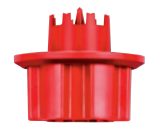
The TCM-X installation tool is a convenient hand-driven hole saw sized perfectly for TCM-X mic installation in ceiling tiles. It cuts a 35mm hole for the mic's threaded stem.
TCM-X-FM Flush Mount Kit
The plenum rated TCM-X-FM Flush Mount Kit allows users to install the TCM-X mic recessed into the ceiling tile or drywall for a low profile appearance.
The kit supports two LED viewing angles: Flush mount = 130° viewing angle; Recessed mount = 170° viewing angle with the addition of an included 4mm spacer behind the mic (brings the LED ring flush with the surface for better visibility at a distance). TCM-X with TCM-X-FM protrudes 7.5mm (0.3") from the ceiling without the spacer, and 11.5mm (0.45") with the spacer installed. 
Mic response is unchanged from standard installation in either flush mount or recessed mount.
The TCM-X-FM flush mount kit requires cutting a 162mm (6.38 inches) diameter hole with a minimum mount depth clearance of 64mm (2.5 inches). A layout template is included with the kit. The TCM-X-FM flush mount kit can mount in ceilings with a thickness of 13-24 mm (0.5" - 0.95") using the included C-Ring or 16-25 mm (0.625" - 1") if using an optional TB-1 ceiling tile bridge.
TCM-X-DK Drywall Kit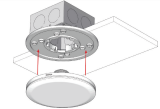
The TCM-X-DK allows for mounting the TCM-X on to a standard electrical back box.
TB-1 Ceiling Tile Bridge
Ceiling Tile Bridge suitable for mounting the TCM-1, TCM-1A, TCM-1EX, TCM-X, TCM-XA, TCM-X-FM in locations which require tile bridge supports.
Seismic Cable Adapter
The seismic cable adapter for is available for all in-ceiling Parlé TCM plenum boxes, as well as TCM-X mic elements.
Further reading
- Parlé-series microphones tips and tricks
- Legacy PPB processing library
- Parlé Processing Block
- Parlé Beam Outputs
- Conference Room Designer Calculator
- Microphone placement: acoustic concepts
- AVB
- Specifying PoE switches for Biamp Tesira devices
- Tesira PoE Power Budget Calculator
- Parlé Installation and Operation Manuals
- Integrating desono™ loudspeakers and AMP-450P backpack amplifiers
- Burst Mode in Biamp PoE+ amplifiers


